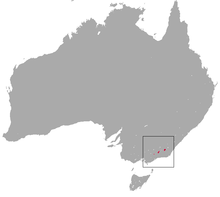Mountain pygmy possum
| Mountain pygmy possum Temporal range: – Recent |
|
|---|---|
 |
|
| Plate from the 1896 description | |
| Scientific classification | |
| Kingdom: | Animalia |
| Phylum: | Chordata |
| Clade: | Synapsida |
| Class: | Mammalia |
| Infraclass: | Marsupialia |
| Order: | Diprotodontia |
| Family: | Burramyidae |
| Genus: | Burramys |
| Species: | B. parvus |
| Binomial name | |
|
Burramys parvus Broom, 1896 |
|
 |
|
| Mountain pygmy possum range | |
The mountain pygmy possum (Burramys parvus) is a small, mouse-sized (weighs 45 grams (1.6 oz)) nocturnal marsupial of Australia found in dense alpine rock screes and boulder fields, mainly southern Victoria and around Mount Kosciuszko in Kosciuszko National Park in New South Wales at elevations from 1,300 to 2,230 metres (4,270 to 7,320 ft). At almost 14 cm (5.5 in), its prehensile tail is longer than its 11 cm (4.3 in) combined head and body length. Its diet consists of insects (such as the Bogong Moth), fleshy fruits, nuts, nectar and seeds. Its body is covered in a thick coat of fine grey fur except for its stomach, which is cream colored; its tail is hairless. On the underside of the female's body is a pouch containing four teats. This possum is the only extant species in the Burramys genus. It is also the only Australian mammal restricted to alpine habitat.
The mountain pygmy possum was first discovered in the fossil record in 1895 when a portion of the jaw and skull bones were found in the Wombeyan Caves in central New South Wales. At the time, the species was believed to be extinct. It was not until 1966 that a living individual was found at a ski resort at Mount Hotham in Victoria. Since that time, the mountain pygmy possum has been located in three isolated, genetically distinct populations in the alpine regions of southern Australia.
Burramys parvus, the mountain pygmy possum, is a small rodent-like marsupial. The mountain pygmy possum has an average weight of approximately 45 g and an average head and body length of 110 mm. The species is sexually dimorphic, with males being slightly larger than females. They have large, forward pointing eyes and short pointed snouts. Mountain pygmy possums exhibit diprotodont dentition, with three upper incisors and two upper premolars. On the syndactylous hind feet, they possess an opposable hallux. In addition, the mountain pygmy possum has a pouch which opens anteriorly and contains 4 teats. Pygmy possums are covered in a layer of fine, dense fur. Their pelage is grayish-brown on the dorsal side, with a darker stripe along the midline of the back, and a pale cream color on the ventral side. They typically have a darker gray ring surrounding the eyes. During breeding season, males become more tawny-orange on the abdomen and flanks. The mountain pygmy possum has a long prehensile tail, averaging about 140 mm in length, which is sparsely haired.
...
Wikipedia

